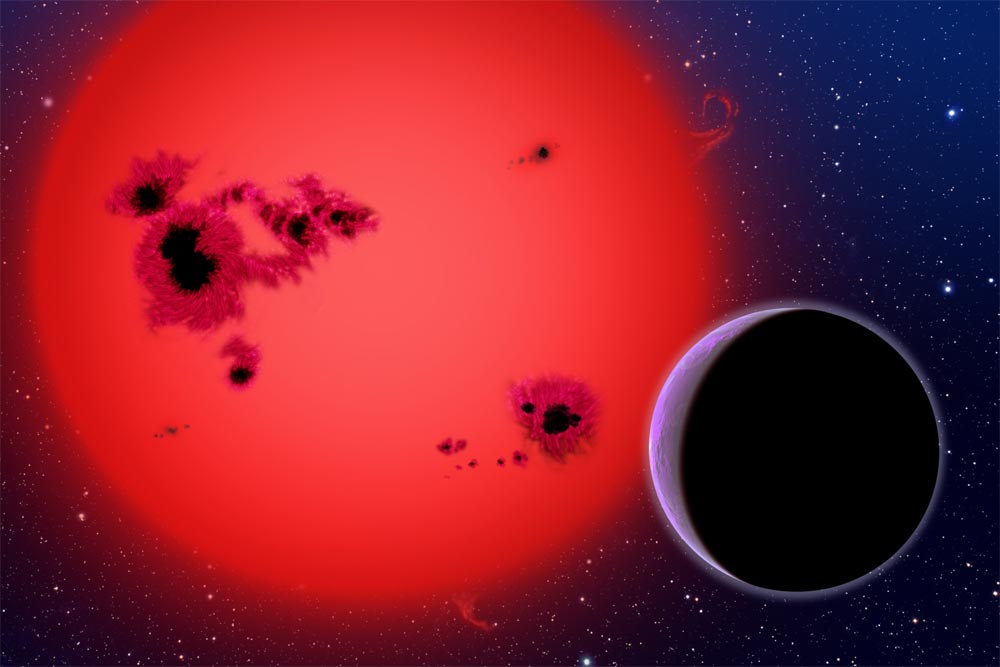Nearby Super-Earth May Be a Waterworld

A rocky andwater-rich planet, not much heftier than our own, has been discovered so closeto our solar system that astronomers one day may be able to study itsatmosphere.
And thoughastronomers are pretty certain the water exists, they don't know its state,with speculations ranging from liquid water to water ice and an exotic statecalled a superfluid.
Theextrasolar planet, now named GJ 1214b, is about 40 light-years away. It orbitsa red dwarf star. It is the only known "Super-Earth" exoplanet ?worlds that have masses between Earth and Neptune ? with a confirmedatmosphere.
"Astronomicallyspeaking, this [planet] is on our block," meaning it's in our cosmicneighborhood, said study leader David Charbonneau of the Harvard-SmithsonianCenter for Astrophysics in Mass. "For perspective, our own TV signals havealready passed beyond the distance of this star."
The planetis about three times the size of Earth and about 6.5 times as massive. It isthe second smallest planet discovered outside of our solar system to date,trailing behind only CoRoT-7b, which is 1.7 times Earth's size and about five times as massive.
GJ 1214b israre among known rockyexoplanets because it partially eclipses, or transits, its star as seenfrom Earth.
Thisfortunate alignment allows astronomers to calculate the size and density of theplanet, and Charbonneau's team thinks GJ 1214b is likely a water world with asolid center. Moreover, the planet has a thick surrounding atmosphere ofhydrogen and helium.
Breaking space news, the latest updates on rocket launches, skywatching events and more!
Normally, aplanet located at that distance from this particular type of star would be sohot that any water on its surface would be in a vapor form.
Butscientists think the thick atmosphere of GJ 1214b creates a high pressureenvironment that keeps water on the surface in a liquid state.
That's justspeculation, however.
"Itreally depends on how hot the planet is on the inside, and we don't know that,"Sara Seager, an astrophysicist at MIT, told SPACE.com. "I think thisplanet doesn?t have liquid water because it is too hot on the inside. I think itgoes from water ice, to a very exotic kind of water ? a superfluid ? and thenit goes to vapor," added Seager, who just published a new eBook onexoplanets called "Isthere Life Out There? The Search for Habitable Exoplanets."
(Seager was not involved in the new planetdiscovery.)
There aredownsides to having such a thick atmosphere: First, the pressure is crushing,making life as we know it difficult. And secondly, the thick atmosphere blockslight from the feeble star from reaching the planet's surface.
"Ifyou picture the sun as a 1,000-watt light bulb, this star is a 3-watt lightbulb," Charbonneau said.
Whateverits exact composition, astronomers are excited about the finding. "We're really looking for a planet that'sa big Earth orbiting in the Goldilockszone of a small star, transiting," Seager said. "This one scoresthree out of four. We're excited because we're getting closer and closer to thething we want to find." The missing piece: GJ 1214b doesn't orbit within the star's habitable, or Goldilocks,zone.
The planetwas discovered using a suite of small, ground-based telescopes and is detailedin this week's issue of the journal Nature.
- Super-EarthsFound Around Sun-Like Stars
- Top 10 MostIntriguing Extrasolar Planets
- Video: PlanetHunter

